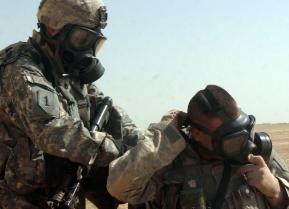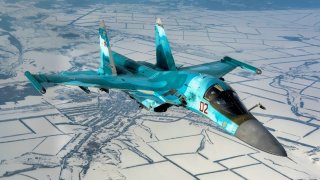Russia's Su-34 Fullback Fighter-Bomber Nightmare Is Historically Bad
Russia has lost as many of its Su-34 fighter-bombers in just the past few weeks, but despite the recent losses, the Kremlin has continued to praise the capabilities of the aircraft.
Summary: Despite recent operational losses, Russia continues to extol the capabilities of the Su-34 Fullback fighter-bomber, highlighting its effectiveness in recent military engagements. The Russian Defense Ministry reported successful strikes by Su-34s using unguided bombs against Ukrainian positions, underscoring the aircraft's role in ongoing military operations.

-The Su-34, developed from Soviet-era programs, became operational in 2014 and represents one of the most advanced aircraft of its kind, featuring twin engines, supersonic speeds, and a range enhanced by aerial refueling capabilities.
-Designed for all-weather, multi-role operations, the Su-34 boasts advanced electronic warfare systems, a distinctive design for improved maneuverability and pilot communication, and a heavily armed loadout for varied combat roles. Despite setbacks, the aircraft's deployment in conflict zones like Syria and Ukraine demonstrates its strategic importance to Russian military objectives.
Russia's Su-34: A Closer Look at the Kremlin's Advanced Fighter-Bomber
Russia has lost as many of its Su-34 fighter-bombers in just the past few weeks, but despite the recent losses, the Kremlin has continued to praise the capabilities of the aircraft.
According to a report from state media outlet Tass, citing the Russian Defense Ministry, a pair of Su-34 jets dropped bombs on a Ukrainian strongpoint in the Krasny Liman area.

"Crews of Su-34 multifunctional supersonic fighter-bombers of the Russian Aerospace Forces struck an enemy strongpoint and manpower in the Krasny Liman area in the zone of the special military operation," the ministry said.
The jets returned safely to their home airfield after receiving intelligence that the targets had been destroyed, while the ministry added that the jets used unguided FAB-500 bombs that are equipped with a kit allowing strikes to originate at a safe distance from the engagement line.
Su-34 Fullback: One of the Kremlin's Best Aircraft
The Sukhoi Su-34 (NATO reporting name "Fullback") multirole strike aircraft is a twin-engine, twin-seat, all-weather supersonic medium-range fighter-bomber, initially developed for the Soviet Air Forces in the 1980s. It was one of the Kremlin's many programs that were forced on the backburner following the dissolution of the Soviet Union and the economic crisis that followed. The program was later revived and the Su-34 formally entered service in 2014.
It really wouldn't be an overstatement to suggest that the Su-34 was one of the best aircraft to come out of the Soviet Union during the late Cold War period. As EuroNews.com reported, the Su-34 has been touted as Russia's most advanced twin-seat supersonic medium-range fighter-bomber a type of combat aircraft not commonly found in Western arsenals, with the U.S.-made F-111 and F-15E Strike Eagle being the most similar multirole counterparts.

The Su-34 is powered by a pair of Saturn AL-31FM1 turbofan engines, the same engines used on the Su-27SM, giving the aircraft a maximum speed of Mach 1.8+ when fully loaded. When equipped with a full weapons load, the Su-34 has a maximum range of 4,000 km (2,500 mi; 2,200 nmi), or further with aerial refueling. It is further equipped with counter-fire and electronic warfare (EW) counter-measures systems.
The fighter-bomber's surface design includes a duckbill-shaped nose cone, two tail fins broadly reminiscent of the Su-27, canards to assist with maneuverability, and a side-by-side cockpit that can potentially facilitate improved communication between the two pilots.
The Su-34 further features a modern glass cockpit, with color multi-function displays, while its nose section accommodates a suite of advanced multi-mode phased array radar, capable of terrain following. The cockpit and some other crucial components and systems are reported to be armored, and the Su-34 is fitted with comprehensive electronic countermeasures equipment. The aircraft has a rearward-facing radar and can launch air-to-air missiles at pursuing enemy aircraft.
The Su-34 typically carries 4,000 kg of weapons, while the maximum capacity is 8,000 kg. Its primary air-to-air weapon is the R-77 (AA-12) missile, with two R-73 (AA-11 or Archer) short-range air-to-air missiles carried on wingtip rails. For ground and naval strike roles, the Russian fighter-bomber can be armed with long-range standoff weapons, including the Kh-55, Kh-59, Kh-59M, Kh-25, Kh-29 air-to-surface missiles, Kh-31, Kh-35, Kh-41 Moskit, and P-800 Oniks anti-ship missiles, and Kh-58 anti-radiation missiles.
It is armed with a 30 mm GSh-301 cannon with 180 rounds, and the aircraft is equipped with 10 underwing and under-fuselage hardpoints for a wide range of weapons, including air-to-air, air-to-surface, anti-ship and anti-radiation missiles, guided or free-fall bombs.
The Su-34 has been employed on missions in Syria and Ukraine.
Author Experience and Expertise: Peter Suciu
Peter Suciu is a Michigan-based writer. He has contributed to more than four dozen magazines, newspapers, and websites with over 3,200 published pieces over a twenty-year career in journalism. He regularly writes about military hardware, firearms history, cybersecurity, politics, and international affairs. Peter is also a Contributing Writer for Forbes and Clearance Jobs. You can follow him on Twitter: @PeterSuciu. You can email the author: [email protected].


